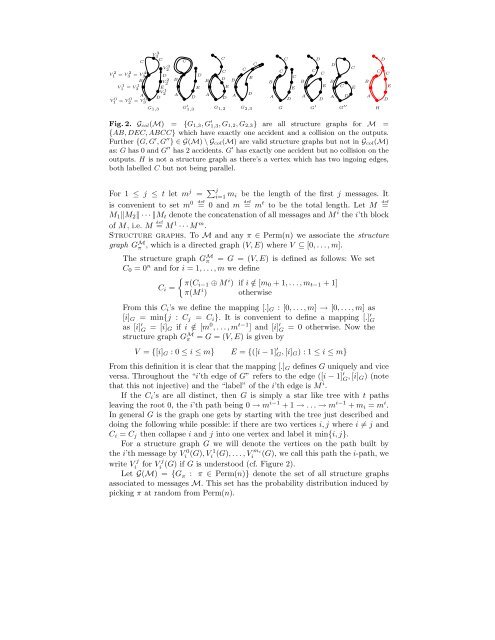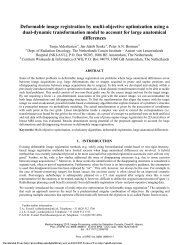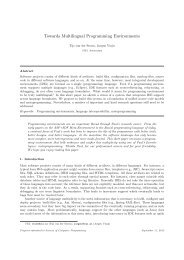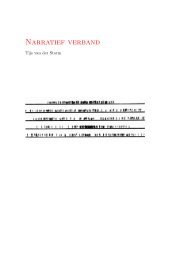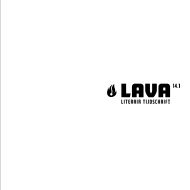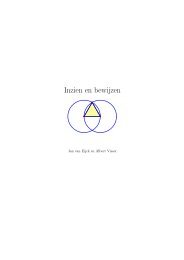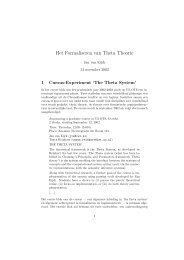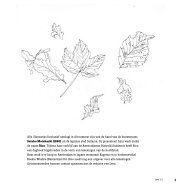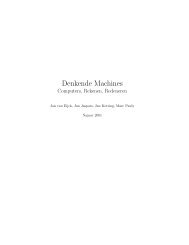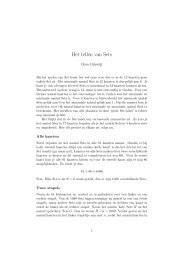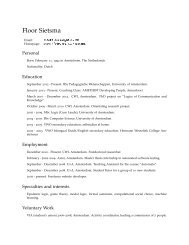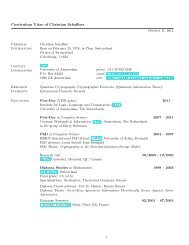A Tight Bound for EMAC - CWI
A Tight Bound for EMAC - CWI
A Tight Bound for EMAC - CWI
You also want an ePaper? Increase the reach of your titles
YUMPU automatically turns print PDFs into web optimized ePapers that Google loves.
C C<br />
C<br />
C<br />
C<br />
D<br />
C<br />
D<br />
C<br />
C<br />
C<br />
C<br />
C<br />
C<br />
D<br />
D<br />
C<br />
B<br />
B<br />
B<br />
D<br />
E<br />
B<br />
B<br />
B<br />
B<br />
E E<br />
E<br />
E C<br />
E<br />
E<br />
A<br />
A<br />
A<br />
A<br />
D<br />
D<br />
D<br />
D<br />
A<br />
A<br />
A D<br />
D<br />
D<br />
G1,3 G ′ 1,3<br />
G1,2 G2,3 G G ′ G ′′<br />
V 0 1 = V 0 2 = V 0 V<br />
3<br />
1 1 = V 1 V<br />
3<br />
2 1 = V 2 3 = V 4 V<br />
3<br />
3 3<br />
V 1 V<br />
2<br />
2 V<br />
2<br />
3 2<br />
B<br />
00 11<br />
00 11<br />
00 11<br />
000 111<br />
000 111<br />
000 111<br />
000 111<br />
A<br />
C<br />
00 11<br />
00 11<br />
00 11<br />
00 11<br />
00 11<br />
00 11<br />
00 11<br />
00 11<br />
00 11<br />
00 11<br />
00 11<br />
Fig. 2. Gcol(M) = {G1,3,G ′ 1,3,G1,2,G2,3} are all structure graphs <strong>for</strong> M =<br />
{AB,DEC,ABCC} which have exactly one accident and a collision on the outputs.<br />
Further {G, G ′ ,G ′′ }∈G(M) \Gcol(M) are valid structure graphs but not in Gcol(M)<br />
as: G has 0 and G ′′ has 2 accidents. G ′ has exactly one accident but no collision on the<br />
outputs. H is not a structure graph as there’s a vertex which has two ingoing edges,<br />
both labelled C but not being parallel.<br />
For 1 ≤ j ≤ t let mj = j i=1 mi be the length of the first j messages. It<br />
0 def<br />
is convenient to set m = 0 and m def<br />
= mt to be the total length. Let M def<br />
=<br />
M1M2···Mt denote the concatenation of all messages and M i the i’th block<br />
of M, i.e. M def<br />
= M 1 ···M m .<br />
Structure graphs. To M and any π ∈ Perm(n) weassociatethestructure<br />
graph GM π , which is a directed graph (V,E) whereV⊆ [0,...,m].<br />
The structure graph GM π = G =(V,E) is defined as follows: We set<br />
C0 =0n and <strong>for</strong> i =1,...,m we define<br />
<br />
π(Ci−1 ⊕ M<br />
Ci =<br />
i ) if i/∈ [m0 +1,...,mt−1 +1]<br />
π(M i ) otherwise<br />
From this Ci’s we define the mapping [.]G :[0,...,m] → [0,...,m]as<br />
[i]G = min{j : Cj = Ci}. It is convenient to define a mapping [.] ′ G<br />
as [i] ′ G =[i]G if i /∈ [m0 ,...,mt−1 ]and[i] ′ G = 0 otherwise. Now the<br />
structure graph GM π = G =(V,E) isgivenby<br />
V = {[i]G :0≤ i ≤ m} E = {([i − 1] ′ G , [i]G) :1≤ i ≤ m}<br />
From this definition it is clear that the mapping [.]G defines G uniquely and vice<br />
versa. Throughout the “i’th edge of G” refers to the edge ([i − 1] ′ G , [i]G) (note<br />
that this not injective) and the “label” of the i’th edge is M i .<br />
If the Ci’s are all distinct, then G is simply a star like tree with t paths<br />
leaving the root 0, the i’th path being 0 → mi−1 +1→ ...→ mi−1 + mi = mi .<br />
In general G is the graph one gets by starting with the tree just described and<br />
doing the following while possible: if there are two vertices i, j where i = j and<br />
Ci = Cj then collapse i and j into one vertex and label it min{i, j}.<br />
For a structure graph G we will denote the vertices on the path built by<br />
the i’th message by V 0<br />
i (G),V1 i (G),...,Vmi i (G), we call this path the i-path, we<br />
write V j<br />
i <strong>for</strong> V j<br />
i (G) ifGis understood (cf. Figure 2).<br />
Let G(M) ={Gπ : π ∈ Perm(n)} denote the set of all structure graphs<br />
associated to messages M. This set has the probability distribution induced by<br />
picking π at random from Perm(n).<br />
00 11<br />
00 11<br />
00 11<br />
H<br />
D<br />
C<br />
00 11<br />
00 11<br />
00 11<br />
D<br />
E


